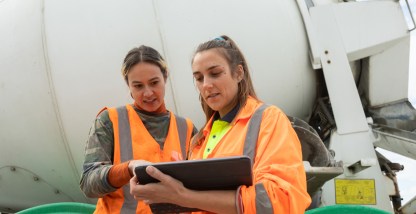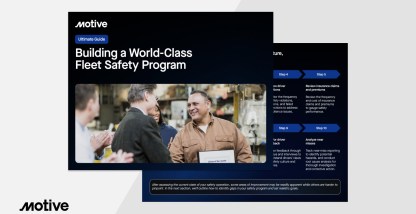As contractors have increased investment in digital solutions, they’ve entered the realm of continuous learning. It’s a realm where feedback is immediate and training never stops. The goal of training is to improve fleet safety and instill better habits. But developing safer habits has never been easy when reinforcement comes sporadically, if at all.
The digital age has left sporadic training behind in favor of something more “accessible and always on.” Through automation, today’s operators are immersed in real-time feedback that takes them to the next level of safety.
When safety training is automated, learning takes place exactly when it’s needed. So that risk is reduced and accidents prevented. In professions like construction and commercial transportation, where one mistake can cost workers their life, the value of accident prevention through fleet safety training can’t be overstated.
What is continuous learning?
Continuous learning is the ongoing expansion of knowledge and skills. Across the physical economy, ongoing training helps fleet drivers and equipment operators develop new skills while reinforcing positive behaviors they’ve already learned. Where traditional training involves learning before doing, continuous learning involves learning by doing. Popular forms include:
- Conferences
- Certification programs
- Professional development workshops
- “Toolbox talks”
- Mentorship programs
- Weekly training seminars
Ongoing fleet safety training in all forms has value. But digital-based training delivers something other styles can’t: Timely feedback.
The timely power of AI and automation
Automated technologies powered by artificial intelligence (AI) provide the right learnings at just the right time. It’s why they prevent accidents so efficiently. According to one insurance broker, virtually any company can benefit from the real-time protection AI tools provide. And “businesses with physically intense operations — such as construction, transportation, warehousing, and farming — may see the greatest benefits.”
As the construction industry moves deeper into digital transformation, contractors are putting learning and development at the forefront. To stay competitive, they have to.
In a recent Deloitte/Autodesk study, more than 1,100 participants said construction firms should emphasize the importance of continuous learning. Respondents also said they want to work where continuous learning is valued. Faced with a years-long labor shortage, there’s an opportunity here for firms to attract new talent.
In the high-risk professions that power the physical economy, AI has turned continuous learning into real-time improvement. Automated driver coaching has played a big part in that. By detecting and alerting to driving-related hazards as they emerge, AI prevents injury and saves lives. The more accurate the AI, the safer the results.
Continuous learning, safer results
With the many hazards on construction sites, it’s easy to forget that construction vehicles pose a considerable risk to workers. Between collisions and rollovers, backing accidents and cargo spills, workers are always vulnerable to injury, whether en route to the jobsite or on it.
That’s where AI dash cams like the one from Motive can help. In-cab alerts generated by artificial intelligence prompt vehicle operators to recognize unsafe driving habits and correct them in real time. Before an accident occurs. Self-coaching tips are automatically sent to drivers through the Motive Driver App, allowing operators to improve without manager intervention.
This proactive approach to fleet safety is a big change from the past, when driver coaching sessions took place in-person and only after an unsafe incident had occurred. Drivers dreaded the in-person chats, feeling blamed for close following and other unsafe habits they weren’t even conscious of.
In-cab alerts and automation are changing all of that. Today’s AI dash cams empower drivers to develop safe habits on the spot, and on their own. In-cab alerts sharpen operator awareness and protect workers proactively in their most vulnerable moments. App-based coaching is much more efficient than the old way of doing things as well.
Lasting benefits of continuous learning
Enhanced fleet safety is the main benefit of continuous learning, but there are others. Such as:
1. Improved productivity
Automated driver coaching and other forms of continuous learning lead to the growth of individuals. As operators shed the unsafe habits of the past, they’re less inclined to make similar mistakes in the future. Safe behavior is productive behavior, both for the operator and the vehicle.
In preventing accidents, continuous learning prevents the injuries and vehicle downtime associated with them. For contractors, that means fewer days away or restricted and more time actually working. With craft workers hard to come by, the last thing construction firms need is for their existing teams to be out with injury. It’s one more reason to invest in digital. When training is continuous, productivity is too.
2. Better job satisfaction.
Few things are as empowering as developing a new skill or being recognized for a job well done. When workers excel in fleet safety, they become part of a special fraternity that is Best in Class. Enhanced performance improves operators’ confidence, making them feel more capable. Reward operators for improvement and their sense of satisfaction will grow.
3. Greater retention.
If improving fleet safety increases employee satisfaction, it also leads to higher retention. When operators are satisfied with their jobs, they stay. Continuous training and the learning that comes with it empowers contractors to make better decisions. The fulfillment they get from enhancing their skills will motivate them to reach future milestones. Even struggling operators improve when backed by technologies that support their growth. So you can keep them on the payroll, too.
4. Better profitability.
Fewer accidents and more productive employees will make your business more profitable. The safer an employee’s driving behaviors, the better they can protect themselves and the vehicle. In the absence of collisions, workers can arrive at the jobsite on time and at full capacity. Not to mention, a better safety record can help you win better rates and more business. Together, these elements can enhance your reputation and strengthen your bottom line.
Start coaching to see continuous learning in action
Ready to take the next step? Download our guide to launching a fleet safety coaching program, then request a demo to get started.










